A few days ago, Jane was browsing for new sunglasses. Before she knew it, every site she visited was showing her relevant ads.
It wasn't magic. Just algorithms working with behavioral data.
But data collection is no longer something we can do in the background. With rising privacy concerns, businesses must now lean on zero-party data.
And what better channel to invest in privacy-first communication than email? A channel where users opt in to get personalized customer experiences.
I'll walk you through the new rules of data collection, how well-established brands are adapting, and what you can do to stay ahead.
- Why Marketers Are Prioritizing Zero-Party Data
- How to Collect Zero-Party Data
- Things to Consider During Zero-Party Data Collection
Why Marketers Are Prioritizing Zero-Party Data
Apple‘s Mail Privacy Protection and GDPR have accelerated the shift to zero-party data. The same goes for Google’s update, although it’s been postponed.
Privacy laws aside, there are more reasons why you should turn to zero-party data.
Accessing High-quality Data
Research shows that 25% of marketers mention poor-quality data as a main reason why they fall short of customer expectations. But your audience chooses to share zero-party data. This means you get more reliable insights than any data collected passively.
Building Trust
With phishing attempts on the rise, users worry about where their sensitive information ends up. As a result, business executives find it challenging to establish trust:
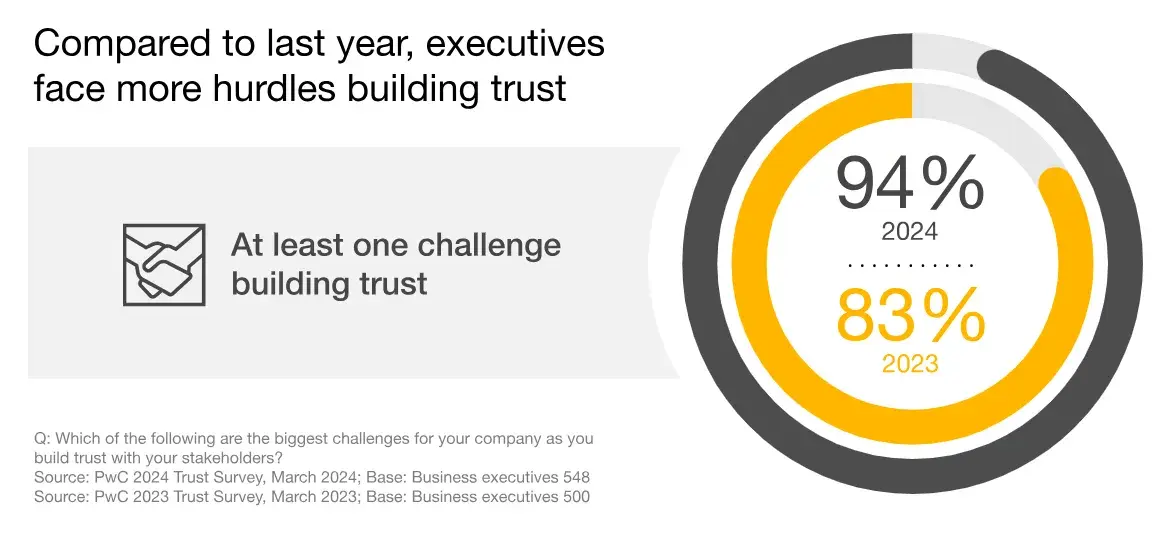
With zero-party data, customers know exactly what they're sharing. And according to Salesforce, 71% of them are more likely to do so if a brand clearly explains how they’ll use the information.
Creating More Personalized (Cross-channel) Experiences
Accurate data means you can deliver meaningful experiences on every channel. For example, a user takes a quiz on a cosmetics site to find their perfect lipstick. At the end, they opt in to receive email and SMS updates. Now the brand can personalize every touchpoint, from emails with blush recommendations to texts with discounts on lip liners.
Boosting Email Deliverability and Interactions
If your emails live up to subscribers’ expectations, they’re more likely to interact and less likely to unsubscribe or mark emails as spam. And this is how you keep email deliverability and sender reputation intact.
How to Collect Zero-Party Data
Below are the most effective ways to gather zero-party data from your audience, along with successful use cases for each.
1. Signup Forms
Tailor your signup form to collect more than a name and email address.
For example, Sephora uses back-in-stock alerts to learn about customers’ preferred communication channels:
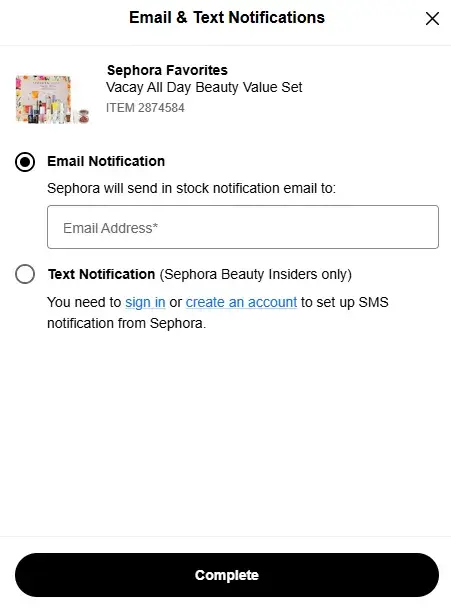
Another approach is to include an email preference field and ask users:
- How often they’d like to receive emails
- What kind of content they prefer
- What products/services they’re interested in
With this tweak, you transform a simple signup form into a lightweight email preference center.
Let's say you want to give your audience the option to choose how often they’ll hear from you — monthly, bi-weekly, or weekly.
With an email tool like Moosend, you can create a preference center so subscribers set their own frequency. What you get is three segments (that update automatically as users change their preferences):
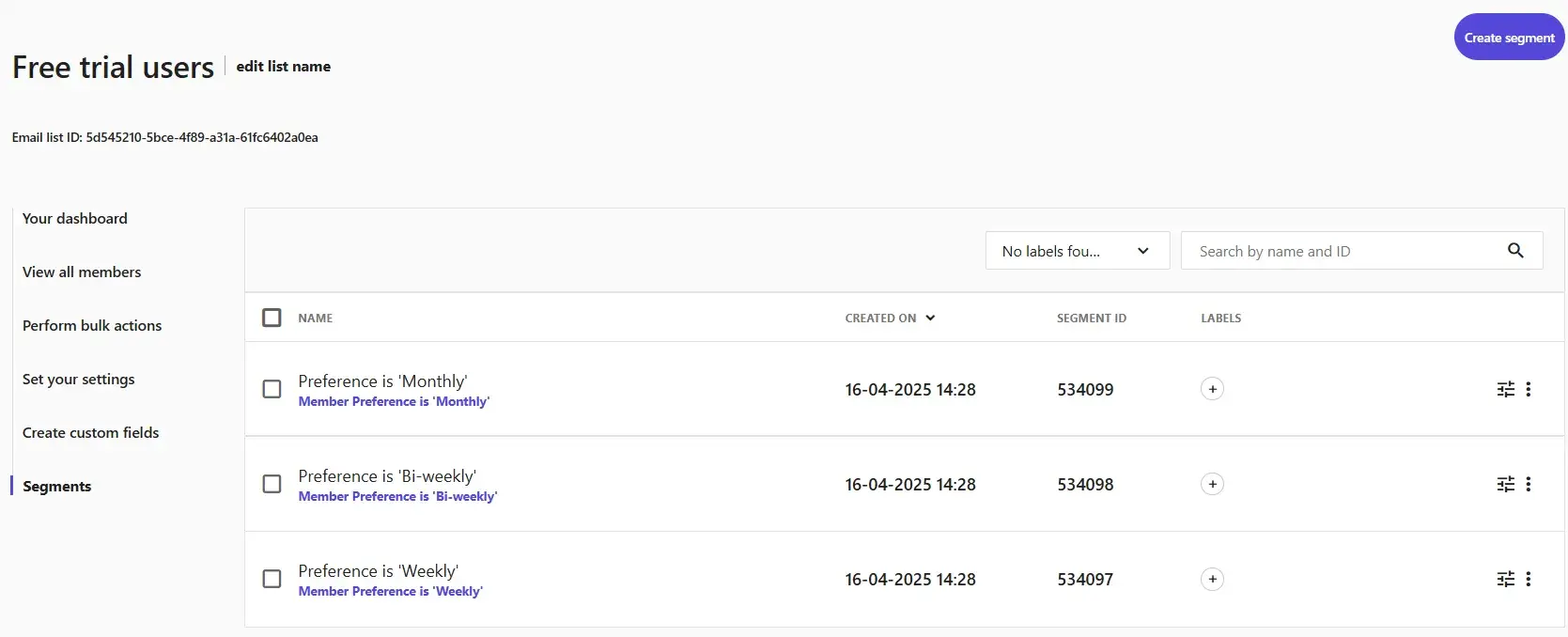
Next time you send an email, you’ll select the relevant group and the campaign will reach the right inboxes.
The more you understand people’s preferences, the more personalized their experience feels. As Georgia Riga, Moosend’s Customer Success Manager, puts it:
“Collecting zero-party data through an email preference center is just the start. The real impact comes from respecting customer preferences in future communications and delivering with consistency.”
2. Account Creation
It's common to ask new users for information such as their job title, company name, and pain points.
However, asking too much upfront could overwhelm them. A better approach? Break the process into a multi-step onboarding to keep users engaged without causing friction.
Start with the essentials and then, depending on your industry, ask a few additional questions. For example, an eCommerce business could ask for the user's birthday to send timely discounts.
Make sure to tie every question to a clear benefit. Canva does an excellent job at this by clarifying how they'll use the info required:
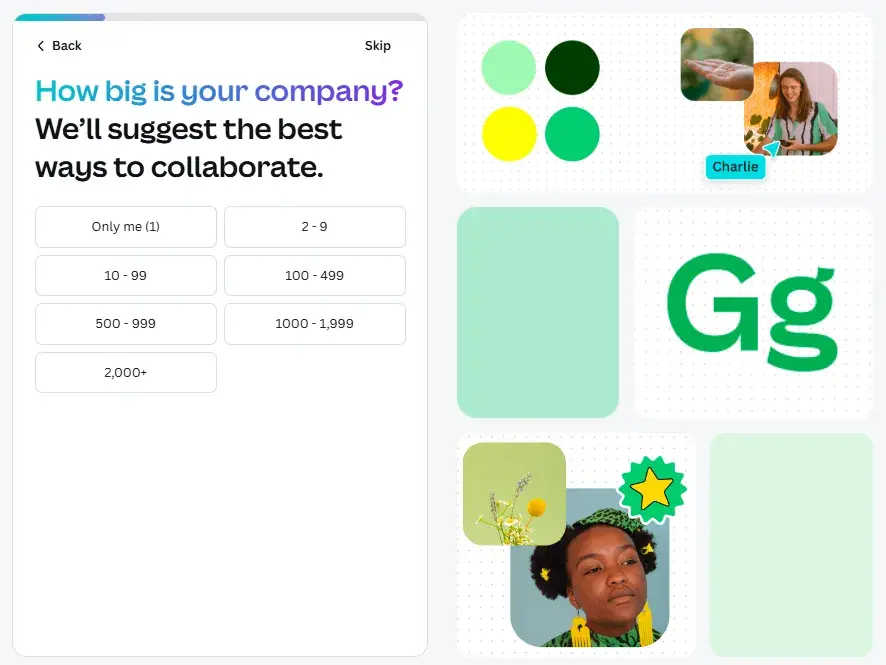
3. Interactive Tools
People love polls and quizzes because they discover new things while having fun.
Think of a quiz that users take and then fill in their email to get personalized results.
There you have it: real-time zero-party data collection, plus a new subscriber (who didn’t feel forced).
Fun aside, the average user won't appreciate going through a tiring process just to get a personalized recommendation.
Stick to 3-5 questions and avoid dropdown menus or open-ended questions. Some brands even let users skip a question or two and still get the results.
Frank Body embeds a skin quiz on its website as part of the signup process and offers an extra incentive.

After clicking the CTA, visitors answer a few quick questions, such as:

4. Reviews, Ratings, and Testimonials
Customer reviews are not just good social proof for potential customers — they also give you insights about your current customers.
Time matters when asking for feedback, though. You want to reach out while their experience is still fresh — ideally, within 1-3 days. That’s when customers are more likely to provide honest, accurate input.
Here’s how and where you can make the request:
- Build an automated post-purchase email that leads users to your website or a review platform.
- Use customer support chatbots that trigger a review request after an issue is resolved.
- Send a short SMS message using a branded link. Text messages work particularly well for mobile apps.
- Reach out to people who mention or tag your brand on social media to see if they're open to sharing their experience.
Consider offering a small incentive, such as a freebie, downloadable resource, or a discount. Also, keep the process short and, if possible, mention how long it will take to complete.
In this email, Virgin Atlantic starts with a heartwarming thank-you note. Moving on, they explain why they need this Net Promoter Score (NPS) survey and the time it takes.
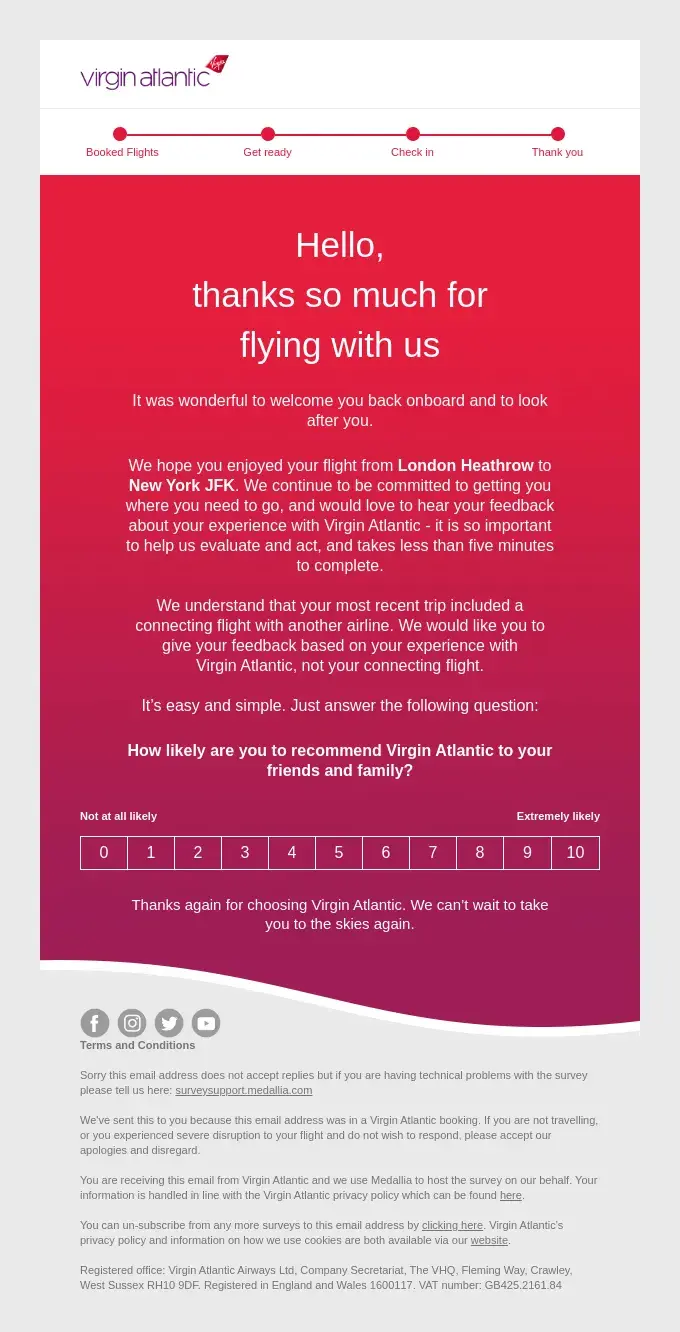
5. Webinar Registrations
Besides being an excellent lead generation tool, webinar registrations help you learn more about your audience, especially in the B2B industry.
What kind of audience insights should you ask for? Try these:
- Name and email address
- Company name, industry, job title
- Custom questions based on the webinar topic
Custom questions may include specific interests and levels of expertise. Want to dig deeper into attendees’ goals? Add an open-ended question to understand why they decided to register.
To remove barriers, make some fields optional. Alternatively, collect more information in a follow-up email after registration.
You can even continue the conversation once the webinar wraps up. Send an email to attendees to collect feedback and find out what else they’d like to learn.
Digital Marketing Institute uses this simple form for lead generation, only asking for basic information to build a professional attendee profile.
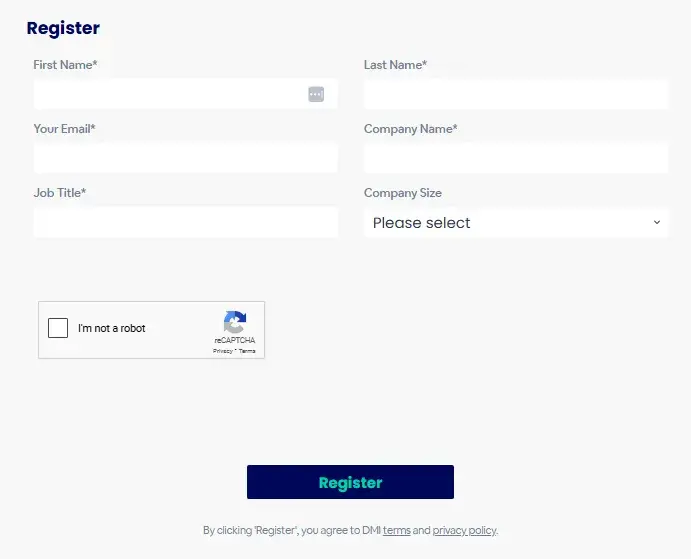
6. Customer Support and Chatbots
When it comes to customer service, chatbots are the first choice both for brands and consumers, according to HubSpot's State of Service Trends Report:
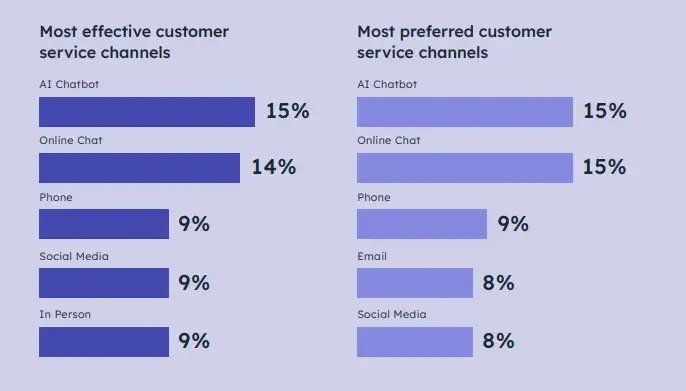
Whether it's on your website, app, or social media channels, chatbots analyze data throughout the conversation to deliver tailored support. To make sure this data is useful, consider these factors:
- Build chatbot conversations with short and simple questions to identify the user's intent.
- Use clickable buttons for replies instead of asking users to type the entire answer.
- Avoid asking for sensitive information upfront. Instead, wait until the user is engaged or once the problem is resolved.
- Follow up with optional feedback requests, like: “Was the issue resolved as expected? If yes, would you care to leave a quick review?”
Attentive keeps things simple by offering links to valuable resources. For specific actions like getting a demo, the visitor has to fill in their email address.
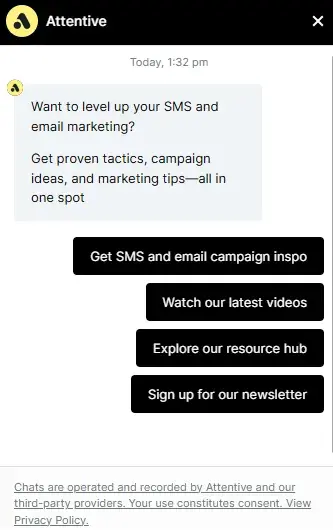
Things to Consider During Zero-Party Data Collection
Users might trust you with their data. But this trust is fragile — send a generic message, and it disappears. To build on that trust, here's what you must keep in mind.
Remember the cause-and-effect pattern.
Subscribers don't passively consume content. They ask questions: “If I tell you X, will you give me Y?” So, when gathering zero-party data, make sure the outcome justifies the sacrifice.
Take this example: A user signs up for an employee management platform. They fill in “HR manager” as their job title and flag employee retention as a challenge. A few hours later, they receive an email series offering actionable employee retention strategies.
When the cause-and-effect relationship feels consistent, subscribers see the relationship as mutual.
Prioritize the data you need.
Zero-party data isn't about bombarding your audience with random questions.
Ask too much — or the wrong things — and you risk raising red flags.
Identify the exact information you need to create tailored emails. Then, separate the must-haves from the nice-to-haves based on your industry and goals.
For example:
- A SaaS company might ask for the user’s job role to provide personalized onboarding.
- For a travel agency, it'd be more helpful to know subscribers’ dream destinations.
- A retailer, on the other hand, could ask for customers’ birthdays to send timely offers.
Consider your audience’s level of engagement.
When you adjust your approach based on the customer journey, data collection feels natural.
Let's say you run a fitness app.
Instead of sending new subscribers a lengthy survey, include a short in-app form to learn more about what content they're interested in and how often they want to hear from you.
When a user reaches a milestone, trigger a push notification that leads to a short survey. Ask about their workout habits to further tailor their fitness plan.
What about members of your loyalty program? This is where you can take zero-party data collection further. These are the people who see the value of your products, so they’re more likely to respond.
Collect new data regularly.
When asking for zero-party data, there are types that you‘ll only ask for once (e.g., your subscriber’s birthday).
Almost any other data, like their family status, could become outdated. User preferences are also subject to change.
That’s why zero-party data collection is not a one-off request, according to Natalia Georgiadou, Moosend's Product Owner:
“You should treat the preference center as a conversation starter instead of a settings page. Build your email preference center with the goal of encouraging that dialogue. And unlock zero-party data that drives real personalization across the entire customer journey.”
So, how can you keep the lines of communication open?
- Set up regular check-ins. Once or twice a year, ask users to update their preferences.
- Build customer profiles gradually. Start with the basics with tools like HubSpot's progressive profiling. Then, collect more specific insights over time.
Making the Shift to Zero-Party Data
Zero-party data goes hand in hand with trust, transparency, and privacy-first marketing. When consumers voluntarily share insights, they’re giving you permission to connect on their terms.
But you’re not just sending emails. You’re engaging in meaningful conversations. Ones that feel like messages from a thoughtful friend who remembers what you love and shows up with the right thing — at the perfect time.





It’s fascinating to see how the landscape of data collection is evolving, particularly in light of privacy concerns. The shift towards zero-party data not only prioritizes user consent but also fosters a deeper connection between brands and consumers.
I really appreciate how you’ve highlighted the shifting landscape of data collection, especially with the increasing emphasis on privacy through zero-party data. It’s interesting to observe how consumers are becoming more aware and protective of their personal information, which has resulted in a significant transformation in marketing strategies. Just last week, I had an experience where I was looking into a specific brand of hiking gear, and suddenly, every platform I visited was inundated with ads from that particular brand. Initially, it felt invasive, but then I reflected on how effective and personal it felt, albeit a bit too tailored for comfort.